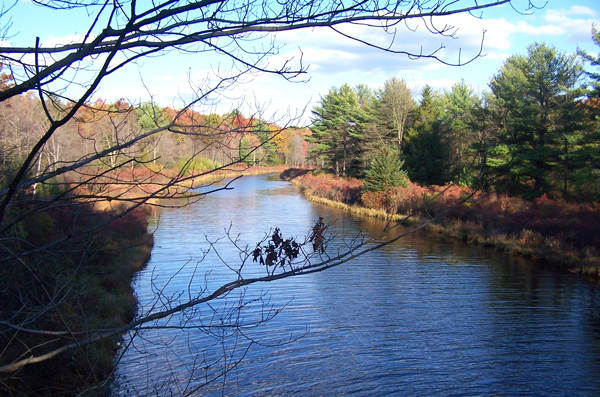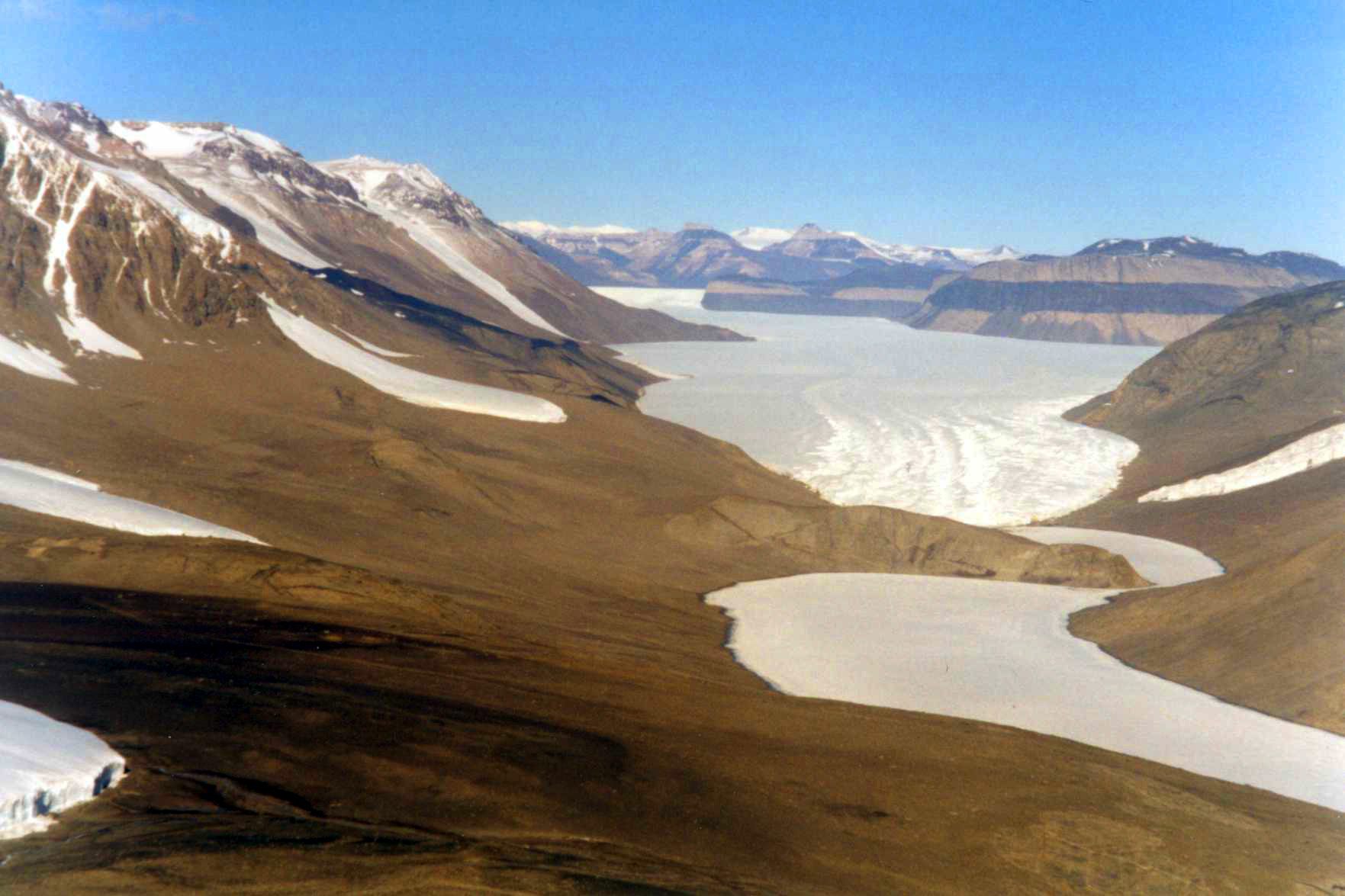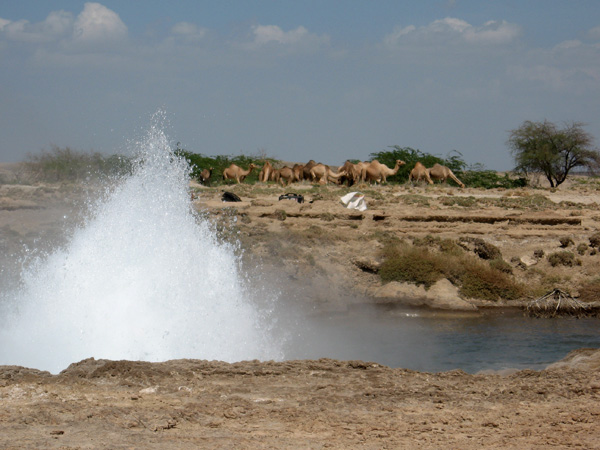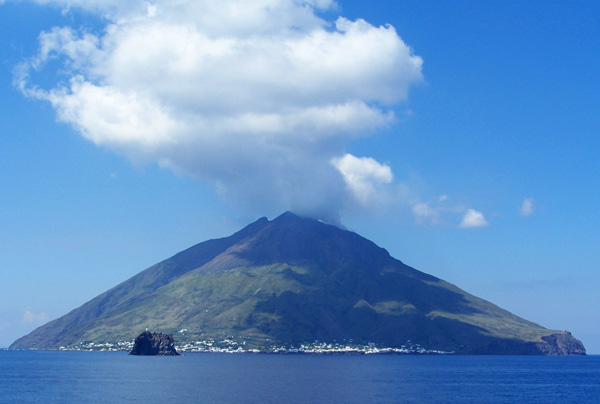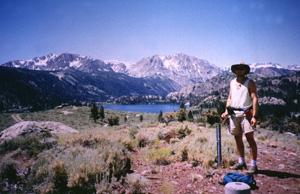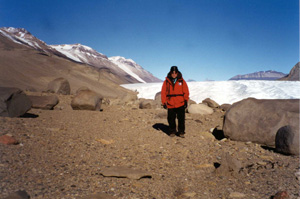 |
|
 |
 |
Rare Gas Lab Research Principle Investigator: Professor Robert J. Poreda |
| Rare Gas HomeAnalytical Capabilities ResearchContacts | Technical Associate: Previous graduate students: |
Tom Darrah (PhD 2009) |
||
Current research projects: |
||||
Groundwater Contamination and Age-Dating [back to top] |
||||
We use tritium (3H) and 3He to determine the flow and age distribution of shallow groundwater. We link the tritium/3He analyses to the study of a number of non-conservative solutes in groundwater to determine rates of degradation and/or mass fluxes into sensitive ecosystems (e.g. Cape Cod, Alabama Coastal Plain, Bangladesh). The 3H/3He method can effectively determine the spatial variability of recharge in shallow systems. As an example, from an estimate of recharge in coastal aquifers, we can calculate the mass transport (by groundwater) of contaminants/solutes to the coastal ocean. A significant groundwater flux can alter our understanding of the residence time of certain solutes in the ocean and may be a significant nutrient source locally. In regional systems beyond the age of tritium-3He, we examine the helium released from aquifer solids (e.g. quartz) to estimate the groundwater age of the fluid. The “helium-4 dating technique” is applicable to many regional systems, including flow in deep sedimentary basins (e.g. Coastal Alabama where 7000 year old waters discharge to the Gulf). |
||||
|
||||
The Effects of Coal-Fired Power Plant Emissions and Fly Ash on a Regional Watershed. Manuscript in progress. (A. Carey, Z. Harrold, T. Darrah, R. J. Poreda) Measurement of helium isotopes in soil gas as an indicator of tritium groundwater contamination. Environmental Science & Technology 40, 2895‐2902 (2006) (K. B. Olsen, P. E. Dresel, J. C. Evans, W. J. McMahon, R. J. Poreda) [pdf] Ground water discharge and nitrate flux to the Gulf of Mexico. Ground Water 42, 401‐417 (2004) (C. B. Dowling, R. J. Poreda, A. G. Hunt, A. E. Carey) [pdf] The groundwater geochemisty of the Bengal Basin; Weathering, chemsorption, and trace metal flux to the oceans. Geochimica et Cosmochimica Acta 67, 2117-2136 (2003) (C. B. Dowling, R. J. Poreda, A. R. Basu) [pdf] Geochemical study of arsenic release mechanisms in the Bengal Basin groundwater. Water Resources Research 38, 1173-1190 (2002) (C. B. Dowling, R. J. Poreda, A. R. Basu, S. L. Peters, P. K. Aggarwal) [pdf] Large groundwater strontium flux to the oceans from the Bengal Basin and the marine strontium isotope record. Science 293, 1470-1473 (2001) (A. R. Basu, S. B. Jacobsen, R. J. Poreda, C. B. Dowling and P. K. Aggarwal) [pdf] |
||||
Climate Change in Antarctica & Evolution of McMurdo Dry Valley Lakes [back to top] |
||||
In an attempt to better understand the long-term climate history of Antarctica, we undertook an investigation of the three major lakes that occupy the Taylor Valley, Southern Victoria Land (78oS). Helium isotope ratios and 3H, He, Ne, Ar and N2 concentration data obtained from hydrocasts in the East (ELB) and West (WLB) Lobe of Lake Bonney provide important constraints on the Holocene evolution of the lake system. Based on the very low concentrations of Ar and N2 in the bottom waters of ELB, this lobe of the lake was free of ice (i.e. in contact with the atmosphere) until 200 ± 50 years ago. Fresh water, flowing over the sill that separates the West and East lobes of the lake, covered ELB, forming a perennial ice cover and inhibiting exchange of gases with the atmosphere. A simple diffusion model of the He, Ne, Ar and N2 into the deep water of the East Lobe constrains the age of this event at 200 ± 50 years. In contrast to the East Lobe, the West Lobe retained an ice cover throughout the Holocene (and potentially much longer). |
||||
|
||||
Groundwater flow system of Wright Valley, Antarctica, using stable isotopes and noble gas. Manuscript in progress. (C. Dowling, T. Darrah, W. B. Lyons, L. Cox, D. Leslie, G. Snyder, R. J. Poreda). Halogen geochemistry of the McMurdo dry valleys lakes, Antarctica: Clues to the origin of solutes and lake evolution. Geochimica Et Cosmochimica Acta 69, 305‐323 (2005) (W.B. Lyons, K. A. Welch, G. Snyder, J. Olesik, E. Y. Graham, G. M. Marion, R. J. Poreda) [pdf] The Helium Isotopic Chemistry of Lake Bonney, Taylor Valley, Antarctica: Timing of Late Holocene Climate Change in Antarctica. Aquatic Geochemistry 10: 353–371, (2004) (R. J. Poreda, A. G. Hunt, W. B. Lyons, K. A. Welch) [pdf] |
||||
Volcanoes and Geothermal Fields [back to top] |
||||
In volcanic systems as unique as Afar (Ethiopia), Lake Kivu and Nyiragongo (DR Congo), the Andean volcanic chain (Chile, Argentina, Bolivia), and Tuscany and the Aeolian Islands (Italy), our research elucidates the processes that control the transfer of volatiles from the magma chamber to the surface. One of the most reliable indicators of the transfer of magmatic gases into surface hydrologic reservoirs is the presence of 3He and ratios to 4He above air. The ratios of magmatic gases such as CO2 and Ar to 3He will change during this transfer process. In addition, the reactivation of a volcanic system is often signaled by changes in the ratios of more soluble gases (CO2) to less soluble ones (Ar). |
||||
|
|
|
||
Noble gas, stable isotope, and volatile chemistry of the Andean volcanic chain. Manuscript in progress. (T. Darrah, F. Tassi, R. J. Poreda, D. Tedesco, O. Vaselli) Volatile chemistry within the kinematically active Tendaho Basin of the Afar Depression. Manuscript in progress. (T. Darrah, F. Tassi, R. J. Poreda, D. Tedesco, O. Vaselli) Gas isotopic signatures (He, C and Ar) in the Lake Kivu region (Western Branch of the East African Rift System): geodynamical and volcanological implications. Journal of Geophysical Research (in press, 2009) (D. Tedesco, F. Tassi, O. Vaselli, R. J. Poreda, T. Darrah, E. Cuoco, and M. M. Yalire) Water and gas chemistry at Lake Kivu (DRC): geochemical evidence of vertical and horizontal heterogeneities in a multi-basin structure. Geochemistry Geophysics and Geosystems 10 (2009) (Tassi, F., Vaselli, O., Tedesco, D., Montegrossi, G., Darrah, T., Cuoco, E. Mapendano, M. Y., Poreda, R., Delgado Huertas, A) [pdf] Sources of nitrogen and methane in Central American geothermal settings: Noble gas and 129I evidence for crustal and magmatic volatile components. Geochemistry, Geophysics, Geosystems 4 (1) (2003) (G. Snyder, R. J. Poreda, U. Fehn, A. Hunt) [pdf] Regional variations in volatile composition: Isotopic evidence for carbonate recycling in the Central American volcanic arc. Geochemistry, Geophysics, Geosystems 2 (2001) (G. Snyder, R. J. Poreda, A. Hunt, U. Fehn) [pdf]
|
||||
Origins of Natural Gas Deposits [back to top] |
||||
Although not often associated with magmatic processes, natural gas deposits often contain significant levels of 3He signifying the importance of magmatic heat in the generation of certain natural gas deposits. In typical crustal settings, the ratios of the radiogenically produced noble gas isotopes 4He, 21Ne and 40Ar can help to constrain flow in sedimentary basins and accretionary prisms (Central America, Barbados). We can also use the rate of release of He from aquifer solids to determine the time/temperature history of the fliuids. Most major mineral phases (e.g. quartz and calcite) release He by volume diffusion at a rate that depends on the temperature and boundary conditions of the sediment. Conversely, release of Ne and Ar typically requires breakdown of mineral phases. Thus the ratios of He to radiogenic Ar and Ne in both natural gases and the associated reservoir rocks can detail the time/temperature history of a sedimentary basin. |
||||
|
||||
Cosmogenic Isotopes and Surface Age-Dating [back to top] |
||||
Cosmogenic 3He and 21Ne present in olivines from surficial deposits can constrain the timing of major flood events in places such as the Grand Canyon over the past 200,000 years. Our work with Cassie Fenton and Thure Cerling (Univ. of Utah) shows that the Grand Canyon floods correlate with lava dams produced from lava flows erupted along the Toroweap Fault in the vicinity of Vulcan’s Throne. Other research focuses on the dating of alluvial fans and debris flow surfaces to evaluate the timing of major faulting in the Basin and Range. This research also has great potential for climate change research because we can precisely measure the age of glacial deposits left by retreating ice sheets and establish a chronology for the transition between glacial and interglacial periods. In the Sierras, we have examined the correlation between the retreat of mountain glaciers in the Sierras and North Atlantic “Heinrich events” (there is a correlation for H1 and H2). In the Dry Valleys of Antarctica, the geologic evidence for changing climatic conditions is very well preserved in the moraines and paleo-beaches of Taylor Valley. |
||||
|
|
|||
Geochemical discrimination of five pleistocene lava‐dam outburst flood deposits, western Grand Canyon, Arizona. Journal of Geology 112, 9-110 (2004) (C. R. Fenton, R. J. Poreda, B. P. Nash, R. H. Webb, T. E. Cerling) [pdf]
|
||||
Meteorite Impacts and the Formation of Earth's Atmosphere [back to top] |
||||
We study noble gases captured within extraterrestrial material. Noble gases can be captured within carbonaceous meteorites, fullerenes, and interplanetary dust particles (IDPs). This research has important implications for the identification of meteorite impacts and the role meteorites play in the evolution of the Earth and life on Earth. By using the unique capability of fullerenes to incorporate extra-terrestrial noble gases during formation, we have determined that a meteorite impact (containing fullerenes) initiated the sequence of events that led to the two largest extinctions of life on Earth. This paper appeared in Science in February 2001. Our NSF and NASA funded research continues to investigate both impact and non-impact sedimentary deposits to sort out the delivery rate of these organic molecules throughout geologic time. The concentration and isotopic composition of the noble gases point to the formation of fullerenes prior to the evolution of our own solar nebula. If future measurements confirm our hypothesis, then fullerenes contained in meteorites play a major role in the delivery of carbon to the surface of the earth and evolution of our atmosphere. The magnetic grains, separated from impact deposits yielded a wealth of information, including Fe-Ni metals and spinel that condensed from the impact cloud. |
||||
Publications: Noble gas and mineralogical tracers of interplanetary dust particles and impact debris in a central Pacific sediment core. Manuscript in progress. (T. Darrah and R. J. Poreda) Noble gas composition of nano-diamonds from the End Pleistocene meteorite impact. Manuscript in progress. (T. Darrah, R. J. Poreda, A. West, J. Kennett) Noble gas and mineralogical evidence of a meteorite impact at the Younger Dryas. Manuscript in progress. (T. Darrah, R. J. Poreda, A. West, J. Kennett, A. Goodyear, L. Becker, R. Firestone) Evidence for an extraterrestrial impact 12,900 years ago that contributed to the megafaunal extinctions and the Younger Dryas cooling. PNAS, 104:16016-16021 (2007). (R. B. Firestone, A. West, J. P. Kennett, L. Becker, T. E. Bunch, Z. S. Revay, P. H. Schultz, T. Belgya, D. J. Kennett, J. M. Erlandson, O. J. Dickenson, A. C. Goodyear, R. S. Harris, G. A. Howard, J. B. Kloosterman, P. Lechler, P. A. Mayewski, J. Montgomery, R. Poreda, T. Darrah, S. S. Que Hee, A. R. Smith, A. Stich, W. Topping, J. H. Wittke, and W. S. Wolbach) [pdf] Bedout: A Possible End-Permian Impact Crater Offshore of Northwestern Australia. Science 304, 1469-1476 (2004) (L. Becker, R. J. Poreda, A. R. Basu, K. O. Pope, T. M. Harrison, C. Nicholson, R. Iasky) [pdf] Chondritic Meteorite Fragments Associated with the Permian-Triassic Boundary in Antarctica. Science 302, 1388-1392 (2003). (A. R. Basu, M. I. Petaev, R. J. Poreda, S. B. Jacobsen, L. Becker) [pdf] Fullerenes and Interplanetary Dust at the Permian-Triassic Boundary. Astrobiology 3, 75-90 (2003) (R. J. Poreda and L. Becker) [pdf] |
||||
